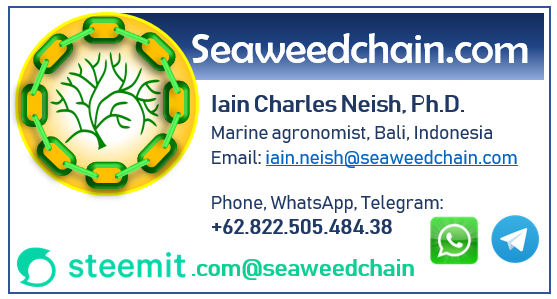In satoumi seascapes generations of people can live and work in harmony with nature.
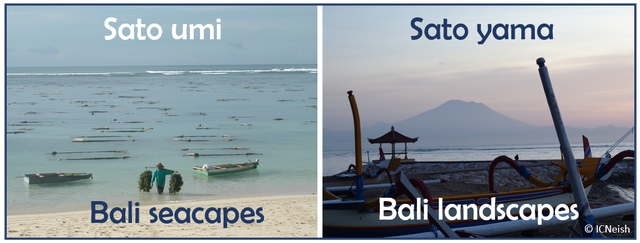
Wherever you go in Bali, you are surrounded by the mountains and the sea. My home-base in Bali is therefore an ideal place to join the concepts of satoumi and satoyama. These are concepts that blend human production systems with the ecology of mountain and ocean habitats. These Japanese concepts refer to practical, useful, grounded philosophical frameworks.
Satoumi is an overarching concept that can be improved and developed
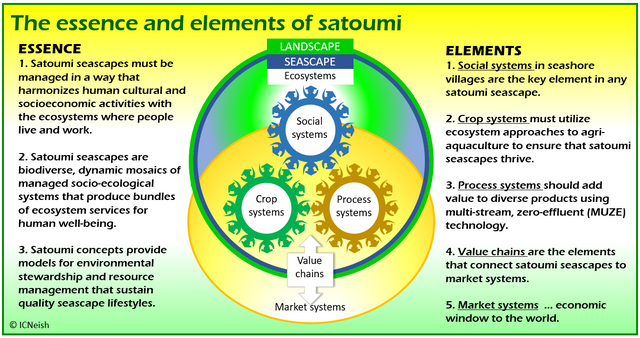
The word ‘satoumi’ was coined by Professor Tetsuo about 1998 and ten years later it was achieving widespread use (Yanagi, 2008). The term ‘satoumi (Japanese for ‘village’ and ‘sea’) was derived from ‘satoyama’ (‘village’ and ‘mountain’). Satoyama is a Japanese concept for long-standing traditions that are associated with land management practices in mountainous regions. If we use English jargon, satoumi seascapes and satoyama landscapes are classified as ‘socio-economic production landscapes (SEPL). That is an awkward phrase that hints at some of what satoumi and satoyama are about, but terms like SEPL have no ‘magic’ about them.
Satoumi is an overarching concept that can be improved on and developed as it is applied to integrating human enterprises into managed coastal sea areas worldwide. Satoumi fosters sustainable use of resources through symbiotic human interaction with ecosystems. It provides a model for environmental stewardship and resource management that contributes to human well-being in sustainable village economies.
Satoumi has been defined in several ways. Originally Yanagi (2008) defined ‘satoumi’ as “high productivity and biodiversity in the coastal sea area with human interaction”. University of the United Nations (UNU) studied various satoyama and satoumi systems in Japan under the framework of the Millennium Ecosystem Assessment Sub-Global Assessment in which they defined satoyama landscapes and satoumi seascapes as “dynamic mosaics of managed socio-ecological systems producing a bundle of ecosystem services for human well-being.” (JSSA 2010).
Satoumi in the real world#
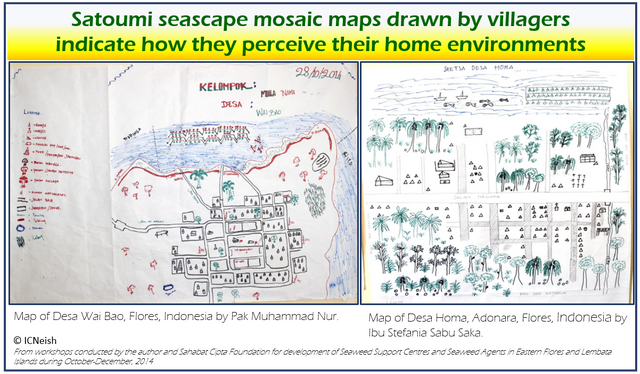
The concept of Sato-umi was embraced as a model for protecting and restoring enclosed coastal seas by the Japanese Government in the Strategy for an Environmental Nation in the 21st Century (2007) and the Basic Plan on Ocean Policy (2008). The concept has also been embraced by several national international initiatives including the Convention on Biological Diversity (CBD), Japan Satoyama Satoumi Assessment (JSSA), the Indonesia GAPURA program and JSPS Asian CORE.
When I am involved in seashore aquaculture developments our first step is always do construct a ‘seascape mosaic’ starting with charts and satellite imagery and then followed by ‘ground-truthing’. The most important aspect of the ground-truthing is to get mosaic maps that are drawn by people who live and work in the seascape being developed. Examples are shown in the image above. Through workshops, interviews and collaborative field work it is possible to get an accurate picture of the status quo of satoumi at the baseline point and to find out what future state that people in the seascape aspire to.
Satoumi aquaculture … many products and many synergies
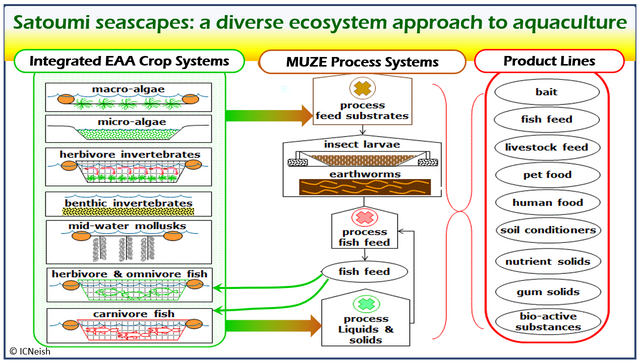
The image above depicts the range of aquaculture activities and the diversity of products that can play a part in satoumi seascape economies. By applying the FAO ‘Ecosystem Approach to Aquaculture’ (EAA) and by using Multistream Zero-Effluent (MUZE) processing, village enterprises can develop their economies in ways that maintain the integrity of ecosystems in the satoumi seascape.
Distributed ledger technologies can play a part in several aspects of the environmental stewardship and resource management that contributes to human well-being in sustainable village economies in satoumi seascapes.
So full Steem ahead!
Cheers, Iain
References:
FAO 2010. Aquaculture development. 4. Ecosystem approach to aquaculture. FAO Technical Guidelines for Responsible Fisheries. No. 5, Suppl. 4. Rome, FAO. 2010. 53p.
JSSA (Japan Satoyama Satoumi Assessment) 2010. Satoyama-Satoumi Ecosystems and Human Well-being: Socio-ecological Production Landscapes of Japan – Summary for Decision Makers. United Nations University, Tokyo, Japan.
Neish IC, Sepulveda M, Hurtado AQ & Critchley AT. 2018. Reflections on the commercial development of eucheumatoid seaweed farming, Chapter 1 in Tropical Seaweed Farming Trends, Problems and Opportunities: Focus on Kappaphycus and Eucheuma of Commerce, Hurtado AQ, Critchley AT & Neish IC [Eds], ISBN 978-3-319-63498-2, Springer.
Neish IC & Suryanarayan S. 2018. Development of eucheumatoid seaweed value-chains through carrageenan and beyond. Chapter 12 in Tropical Seaweed Farming Trends, Problems and Opportunities: Focus on Kappaphycus and Eucheuma of Commerce, Hurtado AQ, Critchley AT & Neish IC [Eds], ISBN 978-3-319-63498-2, Springer.
Yanagi, Tetsuo (2008). “Sato-Umi”—A New Concept for Sustainable Fisheries. In K. Tsukamoto, T. Kawamura, T. Takeuchi, T. D. Beard, Jr. and M. J. Kaiser, eds. Fisheries for Global Welfare and Environment, 5th World Fisheries Congress 2008, pp. 351–358. © by TERRAPUB 2008. [wfcbk_351.pdf]
